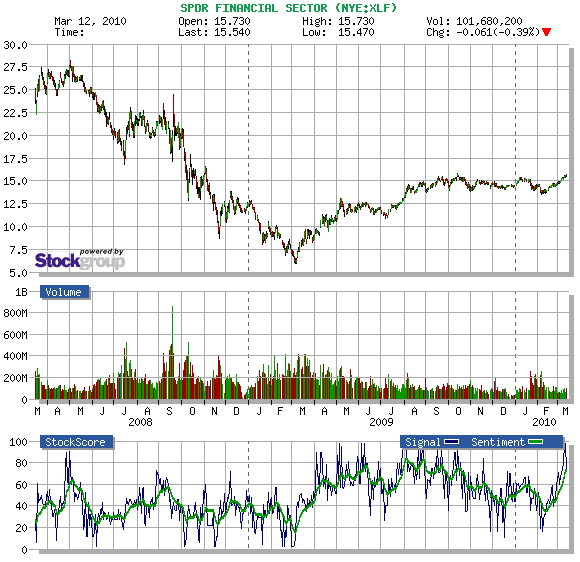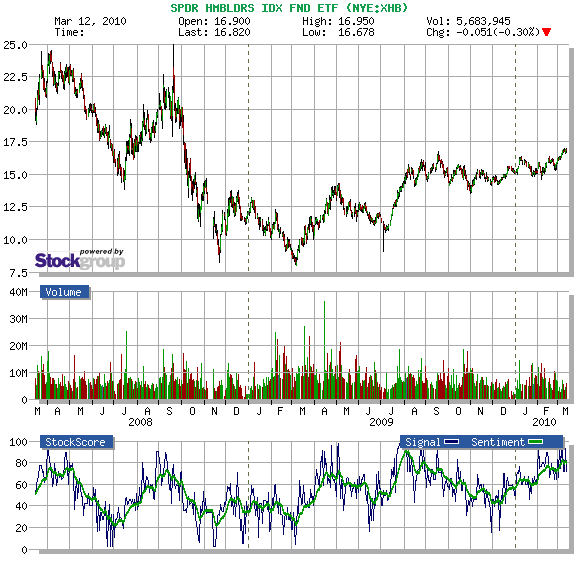Match the Strategy to the Market
Stockscores.com Perspectives for the week ending March 14, 2010
In this week’s issue:
Weekly Commentary
Strategy of the Week
Stocks That Meet The Featured Strategy
![]()
Investors all seem to be searching for that magic formula that will pick out the next winning trade. This quest can seem futile; something that works great one day can lead to total failure on another. Is it the rules that are the problem or is it how they are applied?
Some have a set of rules that they apply when market conditions are right and they find great success. But, when market conditions change and the trend is no longer in their favor, the winners stop coming and they give back all of their gains. In this way, the trader makes a false correlation between their rules and the results. Throwing darts at a board works well in a bull market but when the trend reverses, even the smartest of buyers can lose money.
Others will back test a set of rules and find their winning formula, only to lose money when they apply the rules on actual trades. They struggle to understand how a set of trading rules that worked so well during their testing period fails when they put money on the line.
Although the stock market is located in the same place every day and opens and closes at the same time, smart traders realize that the market can be completely different from one day to the next. This means that it is always smart to start your analysis with an understanding of market conditions. The strategies you choose should evolve out of this understanding and, in keeping with the top down analytical approach, the stocks you finally pick to trade will fall out of the appropriate strategies.
Here is how I approach each trade that I make.
First, I work to understand the market in general. You have to trade the market you have, not the one you wish you could have. I first look at the charts of the Dow, Nasdaq, TSX and TSX venture and ask a simple question, “Who is in control of the market?” I then ask, “Is control likely to change soon?”
Looking at the trend will answer the first question quite easily. If the chart shows falling tops, then the sellers are in control. The buyers are in control if there are rising bottoms. The second question requires a bit more charting knowledge, but it still not that difficult. Trends tend to reverse at major areas of support and resistance. So, a market that is rallying in to a multi year high will probably find some selling pressure soon, and therefore, the trend is likely to reverse. A market that has run away from its trend line is trading with emotion that will likely be rationalized eventually, and we can expect the market to pull back to the trend line. A market that is breaking a trend line may also be setting up for a reversal.
Once I get an understanding of the overall market, I then look to the industry sector groups to see where the money is flowing. I prefer to look at the industry ETFs as they are something that I can buy or sell easily and the charts tend to be better to read than the index charts
With this analysis done, I will now have a good understanding of what is driving the market and where the opportunities are likely to be found. I can now pick filtering strategies that are appropriate for the market conditions.
A market that the buyers have been in control of for some time but is coming in to long term resistance is likely to top out soon. Applying the Reversal of Fortune Strategy is a good way to look for short opportunities in this situation.
If the market is in buyer control but appears to have lots of upside potential still, the Stockscores Simple will find good trading opportunities.
A market that has been falling sharply will bounce around support, so as the market nears support, considering the Hitting Floors strategy is smart.
The Strategy Timing chapter in the StockSchool Pro course goes in to this in more detail.
I have seen many traders make money over a few months and then give it all back when conditions change. They failed to realize that you have to trade the market you have, and that means adjusting your strategy for market conditions. Trading is simple when you have the right strategy, but remember that the right strategy is always changing. So too, must you.
![]()
The markets have been very strong for the past five weeks and are due for a round of profit taking. I expect that this profit taking may begin next week, particularly in Financial and Retail stocks which have gone up very quickly in a short period of time. However, we should consider a pull back in the market an opportunity to enter in anticipation of a longer term upward trend.
The strength in Financial and Retail stocks is a good indication that the economy is getting better. The banking system problems are what started this recession and that hurt consumers. Improving bank stocks means the root cause of economic weakness are improving and if consumers are starting to spend again then the psychology is improving.
I went through a lot of the sector ETFs using the Stockscores Trading Desk. You can do this too as I have saved these groups of ETFs for everyone to look at. To do so, log in at http://tradingdesk.stockscores.com and go to the Chart Watch section. The list of Sectors that I have created is in the right sidebar.
If you are a conservative, long term investor, a few ETFs that I think are worth considering are shown below. Ideally, you will enter in the next few weeks on a pull back if one occurs but it is alright to begin building these positions now. These picks are based mainly on the long term weekly charts which are improving
![]()
1. XLF
XLF gave a strong sign that it will start a pull back early next week but the long term chart is very good. Swing traders may want to play it from the short side next week but after some profit taking I expect that the longer term upward trend will resume so buyers should look at a pull back as an opportunity to buy this sector at a better price. Long term support on this chart$14.30, I think a pull back to $15 is quite possible.

2. XHB
The home building stocks are improving and the XHB ETF is trading through resistance that has held up since September of 2009. The rising bottoms on the chart are a sign of optimism, I consider this ETF good so long as it can stay above $15.25.

Click HERE if you want to learn from some of the timeless advice from some of worlds best traders including the very successful Tyler Bollhorn.
References
Get the Stockscore on any of over 20,000 North American stocks.
Background on the theories used by Stockscores.
Strategies that can help you find new opportunities.
Scan the market using extensive filter criteria.
Build a portfolio of stocks and view a slide show of their charts.
See which sectors are leading the market, and their components.
Tyler Bollhorn started trading the stock market with $3,000 in capital, some borrowed from his credit card, when he was just 19 years old. As he worked through the Business program at the University of Calgary, he constantly followed the market and traded stocks. Upon graduation, he could not shake his addiction to the market, and so he continued to trade and study the market by day, while working as a DJ at night. From his 600 square foot basement suite that he shared with his brother, Mr. Bollhorn pursued his dream of making his living buying and selling stocks.
Slowly, he began to learn how the market works, and more importantly, how to consistently make money from it. He realized that the stock market is not fair, and that a small group of people make most of the money while the general public suffers. Eventually, he found some of the key ingredients to success, and turned $30,000 in to half a million dollars in only 3 months. His career as a stock trader had finally flourished.
Much of Mr Bollhorn’s work was pioneering, so he had to create his own tools to identify opportunities. With a vision of making the research process simpler and more effective, he created the Stockscores Approach to trading, and partnered with Stockgroup in the creation of the Stockscores.com web site. He found that he enjoyed teaching others how the market works almost as much as trading it, and he has since taught hundreds of traders how to apply the Stockscores Approach to the market.
Disclaimer
This is not an investment advisory, and should not be used to make investment decisions. Information in Stockscores Perspectives is often opinionated and should be considered for information purposes only. No stock exchange anywhere has approved or disapproved of the information contained herein. There is no express or implied solicitation to buy or sell securities. The writers and editors of Perspectives may have positions in the stocks discussed above and may trade in the stocks mentioned. Don’t consider buying or selling any stock without conducting your own due diligence.
Disclaimer
This is not an investment advisory, and should not be used to make investment decisions. Information in Stockscores Perspectives is often opinionated and should be considered for information purposes only. No stock exchange anywhere has approved or disapproved of the information contained herein. There is no express or implied solicitation to buy or sell securities. The writers and editors of Perspectives may have positions in the stocks discussed above and may trade in the stocks mentioned. Don’t consider buying or selling any stock without conducting your own due diligence.



